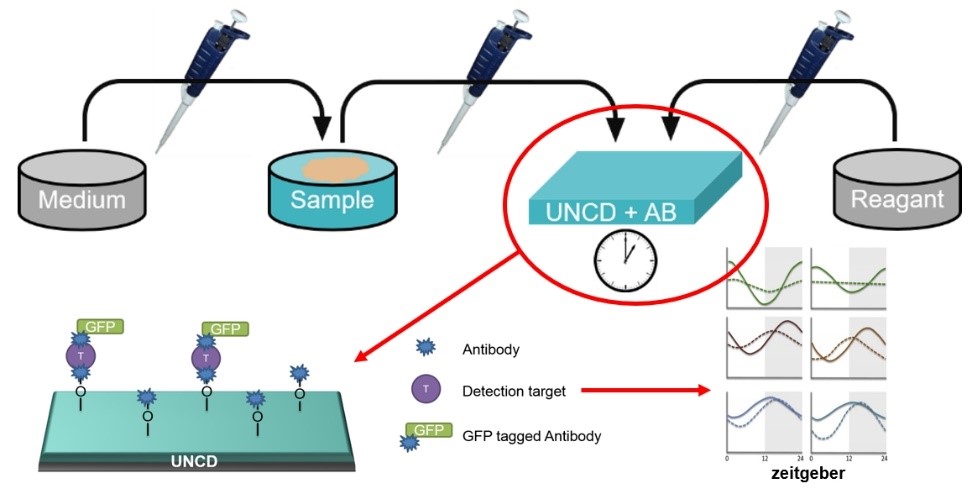Project 6
P6: Diamond-based platforms for biochemical measurements of time-resolved clock cell signaling in response to external zeitgebers and coupling factors
Collaborators
- PI Prof. Dr. Friedmann (Mathematics) (öffnet neues Fenster)
- PI Prof. Dr. Fuhrmann-Lieker (Chemistry) (öffnet neues Fenster)
- PI Prof. Dr. Herberg (Biology) (öffnet neues Fenster)
- PI Prof. Dr. Mayer (Biology) (öffnet neues Fenster)
- PI PD Dr. Neupert (Biology) (öffnet neues Fenster)
- PI Prof. Dr. Stengl (Biology) (öffnet neues Fenster)
Project description
Diamond is a remarkable engineering material due to its outstanding physical properties. Furthermore, it combines a profound biocompatibility with chemical inertness. We have already demonstrated that thin ultrananocrystalline diamond (UNCD) films appear as a perfect platform for incubation of cells (incl. neurons) due to the enhanced cell adhesion as a result of the beneficial morphological and surface chemical properties. The adhesion of circadian pacemaker neurons is improved by an order of magnitude after the surface modifications of UNCD, without application of adhesion proteins and without interfering with the physiological neuronal responses, as measured in Ca2+ imaging assays. After appropriate modification the UNCD surface is accessible for functionalization with linker molecules enabling the covalent bonding of RNA/DNA or proteins.
New tools and assays based on thin UNCD films will be developed to study clock neuron signaling in response to rhythmic external Zeitgebers or coupling factors for the selected model organisms. UNCD films will be deposited by microwave plasma chemical vapor deposition from CH4/N2 mixtures. Their surface will be modified by plasma (O2, NH3, CHF3) or photochemical (UV/O3) processes. The surface termination of UNCD platforms will be patterned in highly hydrophobic or hydrophilic areas to guide the attachment of circadian pacemaker neurons provided by PI Stengl. Special adhesive substrates will be prepared also for experiments with diatoms by PI Fuhrmann-Lieker. Additionally, UNCD surfaces will be applied as basis for biosensors, designed in collaboration with PI Herberg, with antibodies against neurotransmitters or neuropeptides (PDF). Before biofunctionalization, the UNCD will be nanostructured by reactive ion etching with O2 plasma to increase the area for interactions with antibodies. Fundamental protocols for immobilization of proteins, including highly specific and high-affinity antigen binding proteins on UNCD will be established. The spatial resolved interactions of different antibodies with the targets will be modeled by PI Friedmann. The success of the covalent bonding will be evaluated by confocal laser scanning microscopy and quantified with a microplate reader in matrix-scan-mode. Different signaling strategies including sandwich or competitive ELISA with fluorophore-conjugated antibodies will be implemented. The coupling factors released by clock neurons will be characterized as well by mass spectrometry in collaboration with PI Neupert. The developed UNCD-based platforms will be applied to study PDF release as coupling factors of multiscale rhythms in Madeira cockroach (PI Plath/Stengl) and in tardigrades (PI Mayer).

